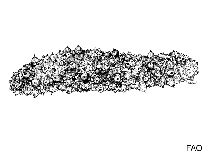Holothuria pervicax Selenka, 1867
Stubborn sea cucumber| Native range | All suitable habitat | Point map | Year 2050 |

|
| This map was computer-generated and has not yet been reviewed. |
| Holothuria pervicax AquaMaps Data sources: GBIF OBIS |
Classification / Names ชื่อสามัญ | ชื่อพ้อง | CoL | ITIS | WoRMS
Holothuroidea | Holothuriida | Holothuriidae
Environment: milieu / climate zone / ระดับความลึก / distribution range นิเวศวิทยา
; ระดับความลึก 0 - 20 m (อ้างอิง 81020). Tropical
Distribution ประเทศต่างๆ | พื้นที่จำแนกตาม FAO | ระบบนิเวศหลายระบบ | การปรากฏขึ้น,การเกิดขึ้น,พบ | การแนะนำ
Indo-West Pacific.
Length at first maturity / ขนาด / Weight / Age
วัยเจริญพันธุ์: Lm ? range ? - ? cm Max length : 35.0 cm TL เพศผู้/กระเทย; (อ้างอิง 92930)
Life cycle and mating behavior วัยเจริญพันธุ์ | การสืบพันธุ์ | การวางไข่ | Eggs | ความดกของไข่ | Larvae
Main reference
อ้างอิง | ผู้ประสานงาน | ผู้ร่วมมือ
Hartati, S.T., I.S. Wahyuni and U.N. Badri 2050 Jenis-Jenis Teripang Di Indonesia: Sea Cucumber species of Indonesia. Research Institute for Marine Fisheries. (อ้างอิง 75656)
IUCN Red List Status
(อ้างอิง 130435: Version 2025-1)
CITES status (อ้างอิง 108899)
CMS (อ้างอิง 116361)
Threat to humans
Human uses
การประมง: การค้า
| FishSource |
เครื่องมือ
ข้อมูลเพิ่มเติม
องค์ประอบของอาหาร
การบริโภคอาหาร
ผู้ล่า
Max. ages / sizes
Length-weight rel.
Length-length rel.
Length-frequencies
Mass conversion
อุดมสมบรูณ์
แหล่งที่มาจากอินเตอร์เน็ต
BHL | BOLD Systems | CISTI | DiscoverLife | FAO(Publication : search) | Fishipedia | GenBank (genome, nucleotide) | GloBI | Gomexsi | Google Books | Google Scholar | Google | PubMed | แผนภูมิชีวิตแบบต้นไม้ | Wikipedia (Go, ค้นหา) | บันทึกทางด้านสัตววิทยา



